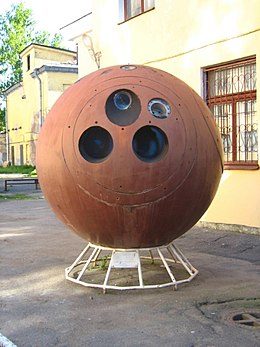Kosmos 7
 A Zenit reentry capsule | |
| Names | Zenit 2-4 Sputnik 17 |
|---|---|
| Mission type | Optical imaging reconnaissance Radiation |
| Operator | Soviet space program |
| Harvard designation | 1962 Alpha Iota 1 |
| COSPAR ID | 1962-033A |
| SATCATno. | 346 |
| Mission duration | 4 days |
| Spacecraft properties | |
| Spacecraft type | Zenit-2 |
| Manufacturer | OKB-1 |
| Launch mass | 4610 kg[1] |
| Start of mission | |
| Launch date | 28 July 1962, 09:18:31GMT |
| Rocket | Vostok-2 |
| Launch site | BaikonurSite 1/5 |
| Contractor | OKB-1 |
| End of mission | |
| Disposal | Recovered |
| Landing date | 1 August 1962 |
| Landing site | Kazakhstan |
| Orbital parameters | |
| Reference system | Geocentric[2] |
| Regime | Low Earth |
| Perigee altitude | 197 km |
| Apogee altitude | 356 km |
| Inclination | 64.95° |
| Period | 90.1 minutes |
| Epoch | 28 July 1962 |
Zenit programme Zenit-2 | |
Kosmos 7(Russian:Космос 7meaningCosmos 7), also known asZenit-2 No.4and occasionally in the West asSputnik 17was aSovietreconnaissance satellitelaunched in 1962. It was the seventh satellite to be designated under theKosmossystem, and the second successful launch of a Soviet reconnaissance satellite.[3]
Spacecraft
[edit]Kosmos 7 was aZenit-2satellite, a first generation, low resolution reconnaissance satellite derived from theVostok spacecraftused forcrewedflights.[1]It also marked the first successful launch of aVostok-2,on the second attempt. It had a mass of 4,610 kilograms (10,160 lb).[1]The first Vostok-2 launch, also carrying a Zenit-2 satellite, suffered an engine failure seconds after launch on 1 June 1962, fell back to earth and exploded within 300 metres (980 ft) of the launch pad.
Kosmos 7 was one of a series of Soviet Earth satellites whose purpose was to study outer space, the upper layers of the atmosphere, and the Earth. Scientific data and measurements were relayed to Earth by multichannel telemetry systems equipped with space-borne memory units.
Mission
[edit]Vostok-2,s/nT15000-07, was used to launch Kosmos 7.[4]The launch was conducted fromSite 1/5at theBaikonur Cosmodrome,and occurred at 09:18:31GMTon 28 July 1962.[5]Kosmos 7 was placed into alow Earth orbitwith aperigeeof 197 kilometres (122 mi), anapogeeof 356 kilometres (221 mi), aninclinationof 64.95°, and anorbital periodof 90.1 minutes.[2]It conducted a four-day mission, before being deorbited and landing byparachuteon 1 August 1962, and recovered by the Soviet forces in the steppe inKazakhstan.[6]
It was the second Zenit-2 to reach orbit, the first beingKosmos 4.The next Zenit-2 launch will beKosmos 9.[3]In addition to reconnaissance, it was also used for radiation measurements made for safety during the flight of theVostok 3andVostok 4spacecraft.[1]
See also
[edit]References
[edit]- ^abcd"Cosmos 7: Display 1962-033A".nssdc.gsfc.nasa.gov.NASA. 27 February 2020.Retrieved23 April2020.
 This article incorporates text from this source, which is in thepublic domain.
This article incorporates text from this source, which is in thepublic domain.
- ^ab"Cosmos 7: Trajectory 1962-033A".nssdc.gsfc.nasa.gov.NASA. 27 February 2020.Retrieved23 April2020.
 This article incorporates text from this source, which is in thepublic domain.
This article incorporates text from this source, which is in thepublic domain.
- ^abWade, Mark."Zenit-2".Encyclopedia Astronautica. Archived fromthe originalon 23 May 2012.Retrieved23 May2009.
- ^McDowell, Jonathan."Launch Log".Jonathan's Space Page.Retrieved23 May2009.
- ^Wade, Mark."Soyuz".Encyclopedia Astronautica. Archived fromthe originalon 7 January 2010.Retrieved23 May2009.
- ^McDowell, Jonathan."Satellite Catalog".Jonathan's Space Page.Retrieved23 May2009.
